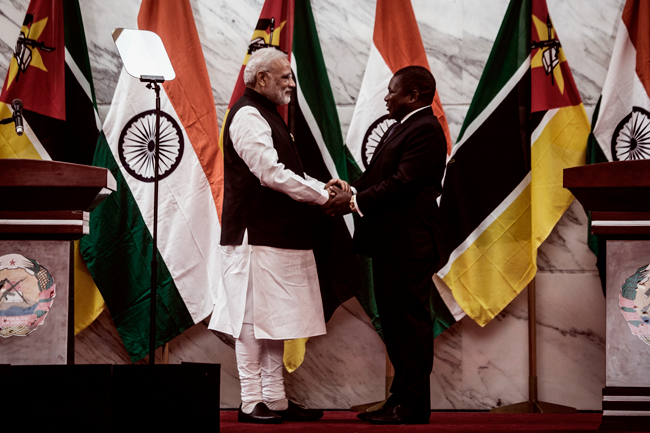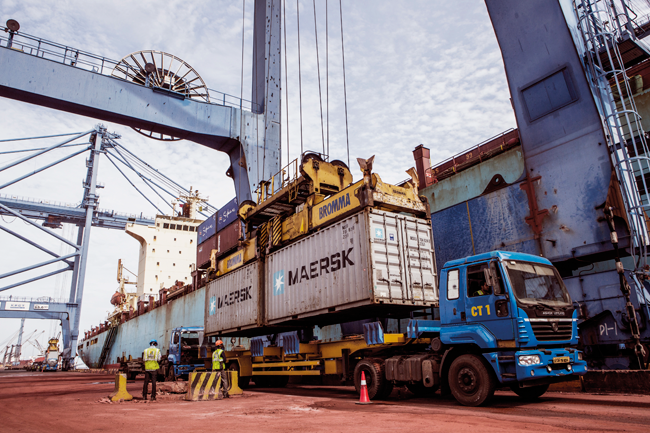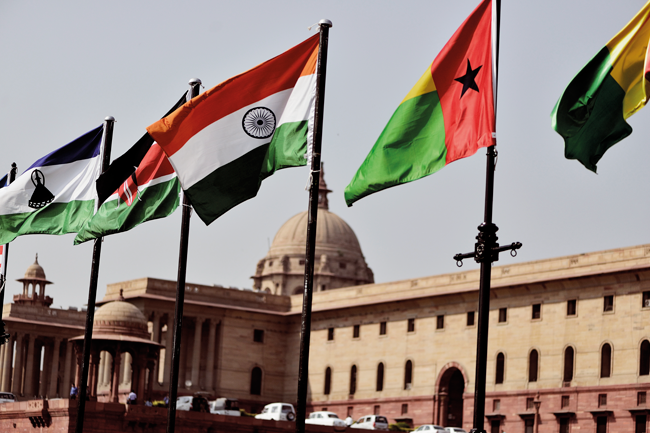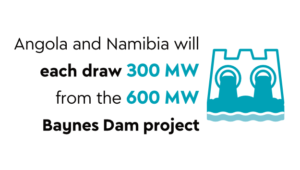India’s quiet push into Southern and East Africa has been likened to an ‘African safari’ by online news site, the Hindu. Other media articles have compared India to ‘an ambitious elephant’ and Africa to the ‘next frontier’. The relationship between India and Africa is often overshadowed by the dramatic Chinese growth story, according to Abdullah Verachia, director of the Centre for Leadership and Dialogue at the Gordon Institute for Business Science (GIBS) at Pretoria University. He is also the head of the GIBS India-Africa Business Network, which has facilitated a number of high-level business engagements.
Verachia describes India’s steady positioning on the global stage as ‘more mindful and moderate’ than China’s, because it’s built on ‘fostering quality relationships over time’. This was also the message that Indian Prime Minister Narendra Modi wanted to convey during his four-nation Africa tour in July 2016. Modi visited Mozambique, Kenya, Tanzania and South Africa, and said his focus was on human development through trade, rather than the extraction of resources.
Although both China and India have shown an appetite for Africa’s mining, commodities and energy sectors, there are differences in the way they conduct business. For one, the scale of the Chinese stake in Africa is massive. ‘China’s annual trade with the continent is three times larger than India’s US$72 billion,’ reported Reuters in 2016. And while China’s trade with Africa is primarily state-driven, India’s private sector has been instrumental in the nation’s foray into the African continent.
Furthermore, India’s focus is extending across diverse sectors – far beyond the initial investment by the Tata Motors group (which entered South Africa in the early 1990s) and the obvious emphasis on IT. ‘We now have about 160 Indian companies operating in South Africa across multiple sectors, which has created a truly significant number of jobs. As a consequence, we’re seeing a new wave of more medium-sized companies and new sectors looking at South Africa,’ says Veruchia. There is interest in healthcare and pharmaceuticals, education, fast-moving consumer goods, the automotive sector and the agricultural value chain, as well as renewed interest from Indian mining companies.
‘We also still see a strong continuation from Indian financial services companies operating in South Africa, with the State Bank of India, the Bank of India, the Bank of Baroda, EXIM Bank and ICICI [Industrial Credit and Investment Corporation of India] among those already invested here,’ he says.
‘The next wave of investment also includes interest from some of the next tier of Indian IT firms beyond the “big five”.’
The ‘big five’ Indian IT companies, best known by their acronyms, are generally understood to include TCS (Tata Consultancy Services), Infosys, Wipro (Western India Products Limited), HCL (Hindustan Computers Limited) and Cognizant.

Veruchia explains in a recent article: ‘In 2008, we started seeing massive investment by some of India’s largest IT companies into South Africa, using the country as a base for developing IT competence and deploying it across the continent. Today, India’s top five IT companies have headquarters in South Africa.
‘The service proposition of these Indian IT giants has been focused on servicing medium- and large-scale corporates in South Africa, government and parastatals. Having secured sizeable contracts locally, these companies have now realised that there is significant potential within greater Africa to achieve the same penetration.’
India’s investment in the local IT sector has not only created new employment but also some much needed initiatives to develop critical skills.
One of the first such programmes was KhulaSangam by the FirstRand Foundation. Meaning ‘growing by coming together’ in Zulu and Hindi, this programme bridges the gap between tertiary education and employability. Young South African graduates without a job are sent on a six-month internship to India, where they gather work experience with leading companies; are exposed to international travel and culture; and learn more about high-impact, youth-led community development projects. They are also trained in professionalism, personal development and leadership skills to increase their employability back in South Africa.
This type of exchange benefits both nations but, at the moment, the ease of movement between India and South Africa is severely hampered by a lack of direct flights and onerous visa regulations, which affect business as well as leisure travel.
South African Airways used to operate daily direct flights between Johannesburg and Mumbai but, in 2014, it reduced the frequency and in April 2015 cancelled the route altogether, citing ‘massive losses’. The airline now uses code-sharing agreements to serve Indian destinations.
‘Direct air connectivity between India and South Africa does pose a certain set of challenges, especially with MICE [meetings incentives, conventions and events] groups,’ says Alpa Jani, SA Tourism’s acting hub head (Asia, Australasia and Middle East).
‘Efforts are on to increase seat capacity on relevant flight routes ex-India. Presently, Indian cities are connected to South Africa by Emirates, Ethiopian Airlines, Etihad Airways, Air Mauritius, Air Seychelles and RwandAir, which fly via their respective hubs and domestic India connections.’
She explains that despite the inconvenient stopovers, Indian tourists are enjoying South Africa. ‘Indian arrivals surged 21.7% during 2016 to close at an arrivals figure of 95 377 and eighth position among South Africa’s international source markets. We had 74 158 arrivals from January to September 2017, and we’re hoping to close the year with a sustained growth like the one we had in 2016.’
Tourism is one of the sectors for which the South African government wants to improve market access in order to boost exports to India (the others being military/defence, deep mining, renewable energy and health).
The South African presidency issued a statement during Modi’s Africa tour, saying: ‘We have agreed to expand and improve people-to-people contact through promoting tourism between the two countries. We would like to assure the Indian side that South Africa is a wonderful tourism destination, and that a simplification of South Africa’s visa regime with India is under way.’

SA Tourism promotes South Africa as a value-for-money destination for Indian visitors who, in 2016, spent more than ZAR1.2 billion in South Africa (in-country on-tour spending, excluding advance bookings of flights, attractions and hotels). To encourage more such trips, the tourism body has been running its ‘Learn SA’ training programme in India for the past seven years, with 1 700 travel agents participating in 2017.
‘Through Learn SA, we ensure that Indian travel agents know how to choose the best quality hotels for their customer’s budget and needs,’ says Hanneli Slabber, SA Tourism’s former country manager for India (now regional GM of Asia, Australasia and Middle East). ‘It also teaches them how to choose the best in-destination partners to escort the traveller while on holiday.’
A lot of marketing work is conducted in Hindi, Tamil, Gujarati and other local languages, Slabber noted at the 2017 Hospitality India Awards. The market was shifting, she said, as young Indians wanted to experience things rather than just see them (‘touch, feel, and contribute’) – for instance, to walk up Table Mountain, volunteer for a charity or qualify as a skydiver. What’s more, 80% of the Indian market books less than a month in advance, which creates bottlenecks during peak times but simultaneously presents opportunities for lesser-known destinations, such as Oudtshoorn and Plettenberg Bay. Meanwhile, South Africa is also emerging as a wedding destination, with Indian families booking entire wine farms or private game lodges for lavish celebrations.
Culturally, the nations remain closely entwined as South Africa is home to one of the world’s largest Indian diasporas. In 2015, the Indian population in Africa was around 2.7 million, with more than half living in South Africa, a third in Mauritius and others in Kenya, Tanzania and Uganda, according to the UN’s Africa Renewal Online. These ties will grow even stronger as Modi’s idea of a ‘partnership for prosperity’ goes ahead.
At the 2015 India-Africa Forum Summit, held in New Delhi, he announced a US$10 billion credit line for Indian companies wanting to invest in Africa over the next five years. Africa Renewal reported that Modi also promised grant assistance of US$600 million, which will include an India-Africa Development Fund (US$100 million), an India-Africa Health Fund (US$10 million) and 50 000 scholarships for African students in India.

















